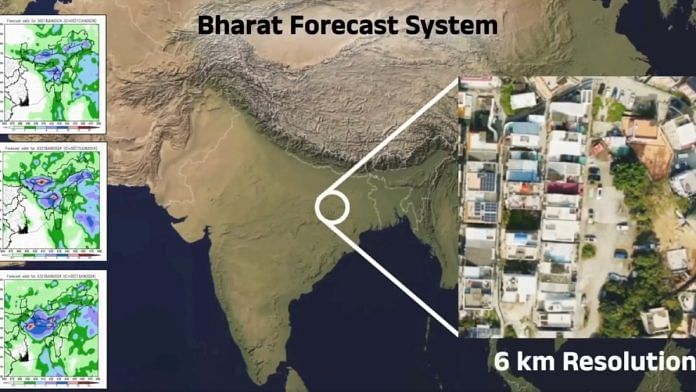New Delhi: The next time a sudden storm or an unseasonal spell of extreme rain, like the one that caught Delhi and the NCR by surprise over the weekend, hits an Indian city, forecasters will be able to call it with precise timings and impact.
India Meteorological Department’s (IMD) new Bharat Forecast System (BFS) promises to improve forecast capabilities and accuracy to a 6 km range, compared with the current 12 km. The new Indian-made model will offer a 30 percent improvement in extreme rainfall forecasts along with other climate change-induced events that are trickier to predict, met department officials said.
The Union Ministry of Earth Sciences (MoES) launched its new weather forecasting system, BFS, in Delhi Monday. The system has been developed by the Indian Institute of Tropical Meteorology (IITM) in Pune, and will be operated by the IMD.
“The new BFS has a resolution of 6 km at the tropics and around 7-8 km resolution at the poles. The current range of our system is only around 12 km. This will remarkably improve our forecasting accuracy,” IITM director Suryachandra Rao said.
ThePrint explains the new technology and how it will improve India’s weather forecasting.
Also Read: What caused unseasonal downpour that wreaked havoc in Delhi NCR? A rare mix of weather phenomena
‘Substantial leap’
IITM scientists, who developed BFS, said the technology had been operational on a pilot since 2022. Trials showed a 30 percent improvement in the forecasting of extreme rainfall events and a 64 percent improvement in forecasts for core monsoon regions. The system also showed improved outcomes for cyclone tracks and intensity forecasts.
Scientists said a version of the global forecasting system (GFS) model has, for the first time, been developed for short and medium-range forecasting over the Indian region using a new grid structure: the triangular-cubic-octahedral (Tco) grid.
The Tco grid, a type of grid used in numerical weather prediction and climate modelling, provides a higher resolution over the tropics at about 6.5 km.
Numerical weather models are computer models that rely on mathematical equations to simulate and predict weather patterns.
India launched its first numerical model in 1999, and then an upgraded Climatology and Persistence Model in 1999. Thereafter, India has been relying on global models for its forecasts.
“This higher resolution represents a substantial leap from the existing Gaussian linear (GFS T1534), which maintains a resolution of 12.5 km across the globe,” a research paper published on the findings of the BFS’s pilot read. “During its trial, the newly developed high-resolution global forecast model showed significantly better skill, particularly with longer lead times and heavier rain categories,” a senior IITM scientist explained.
The climate change obstacle
MoES secretary M. Ravichandran said India is working on further improving its forecast accuracy. “This is a pretty big improvement, but we will not stop at that. Our efforts will be to continuously better our capabilities,” Ravichandran.
But climate change and extreme weather events have become a major problem for weather forecasters. Experts said that lately, weather events have become more unpredictable and seasonal trends are increasingly recording more anomalies.
“Climate change has made weather forecasting challenging not just in India but across the world. But we are striving to make technology and manpower better to make our systems as accurate as possible,” said IMD Director General M. Mohapatra.
(Edited by Sugita Katyal)
Also Read: Everyone in north and central India must adapt to extreme heatwaves. Spring has vanished




